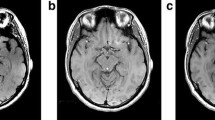Abstract
Introduction
Direct correlation between neuropathological findings and postmortem neuromelanin MR imaging (NmMRI) was performed in the substantia nigra pars compacta (SNc) to clarify the pathological background of the signal changes in normal, Parkinson’s disease (PD), and dementia with Lewy bodies (DLB) cases.
Methods
NmMRI of 10 % formalin-fixed autopsied midbrains was performed in three cases (normal control, DLB, and PD) with a 3T imaging system, using a 3D gradient echo T1-weighted sequence with a magnetization transfer contrast pulse. Neuropathological examinations of the midbrains were performed, and the density of neuromelanin-positive neurons (number per square millimeter) was determined. The extent of iron deposition in the midbrain was also evaluated using ferritin immunohistochemistry. Furthermore, we directly correlated the contrast signal ratio in the SNc and the density of neuromelanin-containing neurons.
Results
Diffuse hyperintense areas in the SNc reflected well-preserved neuromelanin-containing neurons in the normal control case, whereas an iso-intense area in the SNc showed severe loss of neuromelanin-containing neurons in the DLB and PD cases. Increased signal intensity in the SNc was apparently not influenced by iron deposition. Furthermore, a significant positive correlation between signal intensity and the density of neuromelanin-containing neurons was seen in the SNc.
Conclusion
Based on the direct correlation between postportem NmMRI and neuropathological findings, signal intensity in the SNc is closely related to the quantity of neuromelanin-containing neurons but is not influenced by iron deposition.





Similar content being viewed by others
References
Marsden D (1965) Brain pigment and its relation to brain catecholamines. Lancet 10:475–76
Graham DG (1979) On the origin and significance of neuromelanin. Arch Pathol Lab Med 103:359–62
Bazelon M, Fenichel GM, Randall J (1967) Studies on neuromelanin: I. A melanin system in the human adult brainstem. Neurology 17:512–18
Enochs WS, Hyslop WB, Bennett HF et al (1997) Sources of the increased longitudinal relaxation rates observed in melanotic melanoma: an in vitro study of synthetic melanins. Invest Radiol 24:794–804
Enochs WS, Petherick P, Bogdanova A et al (1997) Paramagnetic metal scavenging by melanin: MR imaging. Radiology 204:417–23
Sasaki M, Shibata E, Tohyama K et al (2006) Neuromelanin magnetic resonance imaging of locus ceruleus and substantia nigra in Parkinson’s disease. Neuroreport 17:1215–8
Nakane T, Nihashi T, Kawai H et al (2008) Visualization of neuromelanin in the substantia nigra and locus ceruleus at 1.5T using a 3D-gradient echo sequence with magnetization transfer contrast. Magn Reson Med Sci 7:205–10
McKeith IG, Galasko D, Kosaka K et al (1996) Consensus guidelines for the clinical and pathologic diagnosis of dementia with Lewy bodies (DLB): report of the consortium on DLB International Workshop. Neurology 47:1113–24
McKeith IG, Dickson DW, Lowe J et al (2005) Consortium on DLB: diagnosis and management of dementia with Lewy bodies: third report of the DLB consortium. Neurology 65:1863–72
Schwarz ST, Rittman T et al (2011) T1-weighted MRI shows stage-dependent substantia nigra signal loss in Parkinson’s disease. Movement Disorders 29:1633–38
Hallgren B, Sourander P (1958) The effect of age of the non/hemin iron in the human brain. J Neurochem 3:41–51
Vymazal J, Righini A, Brooks RA et al (1999) T1 and T2 in the brain of healthy subjects, patients with Parkinson disease, and patients with Parkinson disease, and patients with multiple system atrophy: relation of iron content. Radiology 211:489–95
Kinoshita T, Ogawa T, Yoshida Y et al (2005) Curvilinear T1 hyperintense lesions representing cortical necrosis after cerebral infarction. Neuroradiology 47:647–51
Castillo M, Scatliff JH, Kwock L et al (1996) Postmortem MR imaging of lobar cerebral infarction with pathologic and in vivo correlation. Radiographics 16:241–50
van den Hauwe L, Parizel PM, Martin JJ et al (1995) Postmortem MRI of the brain with neuropathological correlation. Neuroradiology 37:343–9
Tovi M, Ericsson A (1992) Measurements of T1 and T2 over time in formalin-fixed human whole-brain specimens. Acta Radiol 33:400–4
Kashihara K, Shinya T, Higaki F (2011) Neuromelanin magnetic resonance imaging of nigral volume loss in patients with Parkinson's disease. J Clin Neurosci 18:1093–6
Kashihara K, Shinya T, Higaki F (2011) Reduction of neuromelanin-positive nigral volume in patients with MSA, PSP and CBD. Intern Med 50:1683–7
Acknowledgments
The authors would like to thank Eijirou Yamashita, Ph.D., Takuro Tanaka, BS, Naoki Iwata, BS, and Shota Sakimoto, BS, for their technical support in obtaining the high-quality MR images used in this study.
Conflict of interest
We declare that we have no conflict of interest.
Author information
Authors and Affiliations
Corresponding author
Additional information
An erratum to this article is available at http://dx.doi.org/10.1007/s00234-017-1822-2.
Rights and permissions
About this article
Cite this article
Kitao, S., Matsusue, E., Fujii, S. et al. Correlation between pathology and neuromelanin MR imaging in Parkinson’s disease and dementia with Lewy bodies. Neuroradiology 55, 947–953 (2013). https://doi.org/10.1007/s00234-013-1199-9
Received:
Accepted:
Published:
Issue Date:
DOI: https://doi.org/10.1007/s00234-013-1199-9




